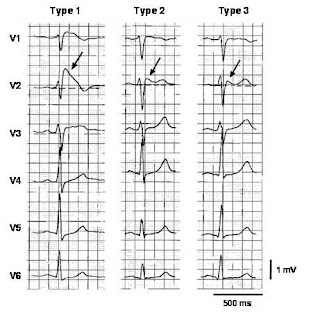OK, Right bundle branch block ( RBBB) is certainly a favourite ECG finding your consultant would like to show you during grand round.
How to pick up RBBB? It is easy, always look for rsR pattern in lead V1 with prolonged QRS complex ( it can be normal in partial RBBB). Besides that, pick up the slurred S ( wide negative S) wave in V6.
Common question for MRCP exam, the causes for RBBB, just remember a few important causes below,
1) Normal variant
2) Increased right ventricular pressure,especially in cor pulmonale and sometimes in pulmonary embolism.
3) Congenital heart disease especially atrial septal defect4) Myocardium ischemia, myocarditis etc.
However, you must not miss Brugada syndrome which has quite similar ECG finding such as RBBB as showed below,
The right bundle branch block pattern seen in patients with this syndrome is not actually right bundle branch block but is a function of the unusual repolarization abnormality. The ECG shows ST-segment elevation in leads V1-V3, and patients are at risk for sudden cardiac death.




 There are a few important fact to remember for MRCP,
There are a few important fact to remember for MRCP,
